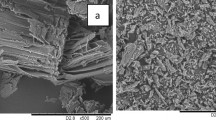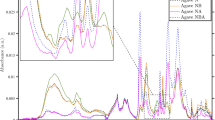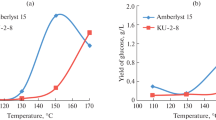Abstract
The methods of obtaining cellulose and cellulose sulfates from birch wood based on the use of one-step catalytic delignification of wood by hydrogen peroxide in acetic acid–water medium were studied. The conditions of birch wood oxidative delignification by acetic acid/hydrogen peroxide mixtures in the presence of sulfuric acid catalyst were optimized in order to obtain an acceptable yield of cellulose product with low content of residual lignin. Cellulose extracted from birch wood by green method was used for preparation of cellulose sulfates in dioxane solution. The homogeneous sulfation of obtained cellulose by chlorosulfonic acid in dioxane allows to reduce the fragmentation of polymer and to synthesize cellulose sulfates with a finer and more homogeneous structure as compared to cellulose sulfates prepared by heterogeneous sulfation in harmful pyridine. Obtained samples of cellulose and cellulose sulfates were characterized by XRD, SEM, AFM, NMR, FTIR, Raman, XPS and chemical methods.











Similar content being viewed by others
References
Anderson RA, Feathergill KA, Diao XH, Cooper MD (2002) Preclinical evaluation of sodium cellulose sulfate (Ushercell) as a contraceptive antimicrobial agent. J Androl 23:426–438
Ardizzone S, Dioguardil F, Mussini T, Mussini P, Rondinini S, Vercelli B, Vertova A (1999) Microcrystalline cellulose powders: structure, surface features and water sorption capability. Cellulose 6:57–69
Brinchi L, Cotana F, Fortunati E, Kenny JM (2013) Production of nanocrystalline cellulose from lignocellulosic biomass: technology and applications. Carbohydr Polym 94:154–169
Browning BL (1967) Methods of wood chemistry, vol. 1, 2. Interscience Publishers, New York
Centi G, van Santen RA (eds) (2007) Catalysis for renewables. Willey, Weinheim
Chen CL, Capanema EA, Gracz HS (2003) Reaction mechanisms in delignification of pine Kraft-AQ pulp with hydrogen peroxide using Mn(IV)-Me4DTNE as catalyst. J Agric Food Chem 51:1932–1941
Cheng HN, Gross RA (eds) (2010) Green polymer chemistry, biocatalysis and biomaterials. ACS Symposium Series, Washington, DC
Chheda JN, Huber GW, Dumesic JA (2007) Liquid-phase catalytic processing of biomass-derived oxygenated hydrocarbons to fuels and chemicals. Angew Chem Int Ed 46:7164–7183
Clark JH, Deswarte FEI (eds) (2008) Introduction to chemicals from biomass. Wiley, Chichester
Das S, Lachenal D, Marlin N (2013) Production of pure cellulose from Kraft pulp by a totally chlorine-free process using catalyzed hydrogen peroxide. Ind Crops Prod 49:844–850
Evtugin DV, Parcoal NC (1997) New polyoxometalate promoted method of oxygen delignification. Holzforschung 51:338–342
Fengel D, Wegener G (1984) Wood: chemistry, ultrastructure, reaction. Walter de Gruyter, Berlin
Gallezot P (2008) Catalytic conversion of biomass: challenges and issues. ChemSusChem 1:734–737
Gericke M, Liebert T, Heinze T (2009) Interaction of ionic liquids with polysaccharides, 8—synthesis of cellulose sulfates suitable for polyelectrolyte complex. Macromol Biosci 9:343–353
Gilbert EE (1965) Sulfonation and related reactions. Interscience Publishers, New York etc
Hallac BB, Ragauskas AJ (2011) Analyzing cellulose degree of polymerization and its relevancy to cellulose ethanol. Biofuels Bioprod Biorefining 5:215–225
Hu F, Jang S, Ragauskas A (2012) Pseudo-lignin formation and its impact on enzymatic hydrolysis. Bioresour Technol 117:7–12
Kamide K, Okajama K (1981) Determination of distribution of sodium sulfate group in glucopyranose units of sodium cellulose sulfate by 13C and 1H nuclear magnetic resonance analysis. Polym J 13:163–166
Kang GJ, Malekian A, Ni YH (2004) Formation of peracetic acid from hydrogen peroxide and pentaacetyl glucose to activate oxygen delignification, solutions. Tappi J 3:19–22
Kuznetsov BN, Kuznetsova SA, Danilov VG, Yatsenkova OV (2008) Catalytic properties of TiO2 in wood delignification by acetic acid—hydrogen peroxide mixture. React Kinet Catal Lett 94:311–317
Kuznetsov BN, Kuznetsova SA, Danilov VG, Yatsenkova OV (2009) Influence of UV pretreatment on the abies wood catalytic delignification in the medium acetic acid—hydrogen peroxide—TiO2. React Kinet Catal Lett 97:295–300
Kuznetsov BN, Kuznetsova SA, Danilov VG, Yatsenkova OV, Petrov AV (2011a) A green one-step process of obtaining microcrystalline cellulose by catalytic oxidation of wood. React Kinet Mech Catal 104:337–343
Kuznetsov BN, Sudakova IG, Celzard A, Garyntseva NV, Ivanchenko NM, Petrov AV (2011b) Binding properties of lignins obtained at oxidative catalytic delignification of wood and straw. J Sib Fed Univ Chem 4:3–10
Kuznetsova SA, Danilov VG, Kuznetsov BN, Yatsenkova OV, Alexandrova NB, Shambasov VK, Pavlenko NI (2003) Environmentally friendly catalytic production of cellulose by abies wood delignification in “acetic acid—hydrogen peroxide—water” media. Chem Sustain Dev 11:141–148
Lucas M, Hanson SK, Wagner GL, Kimball DB, Rector KD (2012) Evidence for room temperature delignification of wood using hydrogen peroxide and manganese acetate as a catalyst. Bioresour Technol 119:174–180
Mac Leod JM (1987) Alkaline sulphite-anthraquinone pulps from softwoods. J Pulp Pap Sci 13:44–49
Neson V (2011) Introduction to renewable energy. CRC Press, Boca Raton
Nishiyama Y, Langan P, Chanzy H (2002) Crystal structure and hydrogen-bonding system in cellulose Iβ from synchrotron X-ray and neutron fiber diffraction. J Am Chem Soc 124:9074–9082
Pario JC, Alonso JV, Santos V (1995) Kinetics of catalyzed organosolv processing of pine wood. Ind Eng Chem Res 12:4333–4342
Park S, Baker JO, Himmel ME, Parilla PA, Jonson DK (2010) Cellulose crystallinity index: measurement techniques and their impact on interpreting cellulose performance. Biotechnol Biofuels 3:10
Peschel D, Zhang K, Aggarwal N, Brendler E, Fischer S, Groth T (2010) Synthesis of novel celluloses derivatives and investigation of their mitogenic activity in the presence and absence of FGF2. Acta Biomater 6:2116–2125
Popplius-Levlin K, Mustonen R, Muovila T, Sundquist J (1991) Milox pulping with acetic acid-peroxyacetic acid. Paperi ja Puu 73:154–158
Simoes JA, Citron DM, Aroutcheva A, Anderson RA, Zaneveld LJD (2002) Two novel vaginal microbicides (polystyrene sulfonate and cellulose sulfate) inhibit Gardnerella vaginalis and anaerobes commonly associated with bacterial vaginosis. J Antimicrob Chemother 8:2692–2695
Sundquist J (1996) Chemical pulping based on formic acid: summary of milox research. Paperi ja Puu 78:92–95
Vasiliu-Oprea C, Nicoleanu J (1993) Micronized (and microcrystalline) celluloses. Obtainment and fields of application. Polym Plast Technol Eng 32:181–214
Vourinen T (1993) The role of carbohydrates in alkali anthraquinone pulping. J Wood Chem Technol 13:97–125
Wang ZM, Li L, Zheng BS, Normakhamatov N, Guo SY (2007) Preparation and anticoagulation activity of sodium cellulose sulfate. Int J Biol Macromol 41:376–382
Wang ZM, Li L, Xiao K-J, Wu J-Y (2009) Homogeneous sulfation of bagasse cellulose in an ionic liquid and anticoagulation activity. Bioresour Technol 100:1687–1690
Weinstock LA, Atalla RH, Reiner R, Moen MA, Hammel KE, Hutman CJ, Hill CL, Harrup MK (1997) A new environmentally benign technology for transforming wood pulp into paper. Engineering polyoxometalates as catalysts for multiple processes. J Mol Catal A 116:59–84
Yamomoto I, Takayama K, Honma K, Gonda T, Matsuzaki K, Uryu T, Yoshida O, Nakashima H, Yamamoto N, Kaneko Y, Mimura T (1991) Synthesis, structure and antiviral activity of sulfates of cellulose and its branched derivatives. Carbohydr Polym 14:53–63
Yao S (1998) Study on biocompatibility in a new biomicrocapsule system. J Chin Biotechnol 14:193–197
Yao S (2000) An improved process for the preparation of sodium cellulose sulphate. Chem Eng J 78:199–204
Zhang K, Brendler E, Fischer S (2010) FT Raman investigation of sodium cellulose sulfate. Cellulose 17:427–435
Zhang K, Brendler E, Geissler A, Fischer S (2011a) Synthesis and spectroscopic analysis of cellulose sulfates with regulable total degrees of substitution and sulfation patterns via 13C NMR and FT Raman spectroscopy. Polymer 52:26–32
Zhang K, Peschel D, Bäucker E, Groth T, Fischer S (2011b) Synthesis and characterisation of cellulose sulfates regarding the degrees of substitution, degrees of polymerisation and morphology. Carbohydr Polym 83:1659–1664
Acknowledgments
The reported study was partially supported by RFBR, research Project No 12-03-93117 and Ministry of Education and Science RF (Project RFMEFI607 14 X0031). This work is part of the GDRI “Catalytic biomass valorization” between France and Russia. The authors thank Dr. A.S. Romanenko, Dr. A.S. Krylov, I.V. Korolkova and V.F. Kargin for AFM, FT Raman, FT-IR, SEM analysis, respectively.
Author information
Authors and Affiliations
Corresponding author
Rights and permissions
About this article
Cite this article
Kuznetsov, B.N., Kuznetsova, S.A., Levdansky, V.A. et al. Optimized methods for obtaining cellulose and cellulose sulfates from birch wood. Wood Sci Technol 49, 825–843 (2015). https://doi.org/10.1007/s00226-015-0723-y
Received:
Published:
Issue Date:
DOI: https://doi.org/10.1007/s00226-015-0723-y




